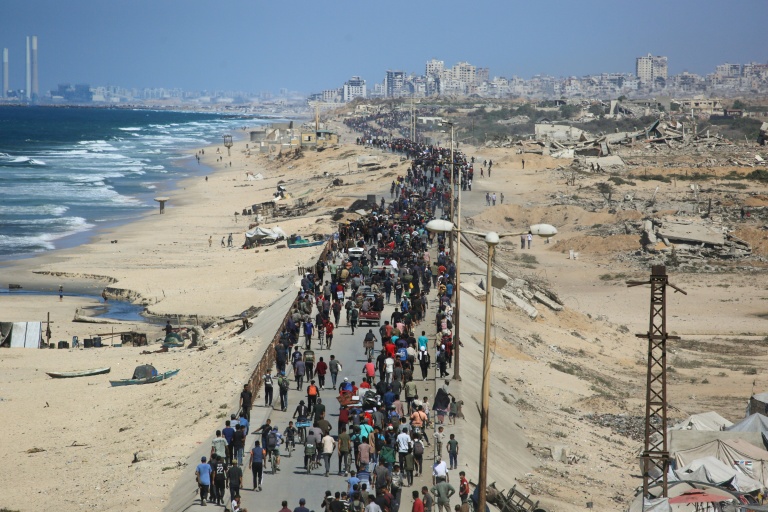
UPDATE: Israel has officially declared a ceasefire, allowing thousands of displaced Palestinians to begin returning home after two years of devastating conflict. The announcement, made on October 13, 2023, at noon (0900 GMT), marks a significant turning point as families hope for a lasting peace, facilitated by US President Donald Trump.
The Israeli military confirmed the cessation of hostilities, stating it is “in preparation for the ceasefire agreement and the return of hostages.” Just three hours later, the US Pentagon confirmed the initial phase of troop withdrawal from Gaza as outlined in Trump’s peace plan.
As the ceasefire takes effect, long lines of Palestinians are making their way back to their devastated homes, particularly from the southern city of Khan Yunis toward northern areas. The United Nations has warned of dire famine conditions, highlighting the urgent need for stability.
Israeli forces still control approximately 53 percent of Palestinian territory. This withdrawal initiates a 72-hour deadline for Hamas to release the remaining hostages. Israel has also released a list of 250 Palestinian prisoners it plans to free, alongside 1,700 Gazans detained since the conflict escalated after Hamas’s attack on October 7, 2023.
Gaza’s civil defense agency confirmed that Israeli troops and armored vehicles are pulling back from critical positions in both Gaza City and Khan Yunis. However, Israel cautioned that certain areas remain off-limits, advising Palestinians to avoid zones where Israeli forces are “adjusting operational positions.”
“We’re going back to our areas, full of wounds and sorrow, but we thank God for this situation,” said Ameer Abu Iyadeh, a resident of Khan Yunis, reflecting the mixed emotions felt by many returning home.
Earlier today, Israeli Prime Minister Benjamin Netanyahu‘s office announced that the government approved a framework for the hostage release deal. “Citizens of Israel, two years ago, the Simhat Torah holiday became a day of national mourning,” he stated. “This Simhat Torah, with God’s help, will be a day of national joy, celebrating the return of all our brothers and sisters held hostage.”
The family of Alon Ohel, one of the 20 living hostages set to be released, expressed their overwhelming emotions as they await his return. The ceasefire agreement, signed earlier this week in Egypt, is seen as a critical step toward ending the war, although several issues, including Hamas’s disarmament, remain unresolved.
Amid celebrations in both Israel and Gaza, senior Hamas official Osama Hamdan stated that the transitional authority proposed by Trump is rejected by their movement. The situation remains fluid, with ongoing discussions about the disarmament of Hamas to be addressed in a second phase of the peace plan.
Residents from various regions of the Gaza Strip reported seeing significant Israeli military withdrawals, particularly from Tal al-Hawa and Al-Shati camps, which had previously endured severe bombardments.
As families return to their homes, the emotional toll is palpable. Areej Abu Saadaeh, a mother who lost her children in the conflict, expressed mixed feelings: “I’m happy about the truce and peace, even though I grieve for my children deeply. Yet, the truce also brings joy: returning to our homes.”
The European Union mission at the Rafah border announced plans to reopen a pedestrian crossing on October 14, allowing further movement for Gazans.
As the ceasefire holds, the world watches closely. What happens next could redefine the future of both Israelis and Palestinians as they navigate the complexities of peace and reconciliation.




